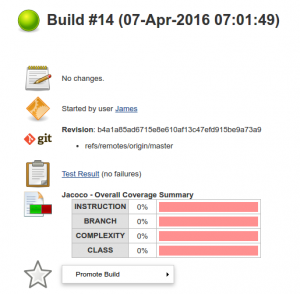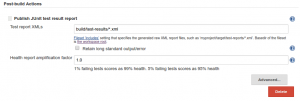This is the first in a series of posts looking at JHipster deployment. This post considers the most basic deployment. Later posts will look at more maintainable set-ups, including continuous integration and deployment pipelines
For me, one of the most exciting things about JHipster is that it makes it feasible to build hobby websites on a full-stack Java/Javascript platform. Basic functionality can be added within a few hours, and pretty good user administration comes as standard.
But, for all web-applications, getting from a feature-complete version to a live application can be a problem. There are several things to consider such as reliability, monitoring and security. This post looks into the minimal configuration required for a hobby site. I’m planning to maintain it as a work-in-progress, so if you have any questions or suggestions, please leave a comment below.
What do we mean by a hobby website?
By ‘hobby website’, I mean something that is created and run for fun. Since it’s not intended to make money, the requirements for uptime and stability are lower than a professional site, and we are probably making a few shortcuts in terms of process. We want it to chug along by itself and check in with it at weekends; we assume we will get pinged for errors, but we won’t respond to them immediately. And we also probably want to spend more time working on code rather then infrastructure.
Indeed, I suspect most people considering a hobby site are not going to run full test suites. While proper testing is more efficient in the long run, and essential on large or collaborative projects, some people enjoy the immediacy of seat-of-the-pants development. Certainly, reputational risks are lower when doing a hobby website. I’m not saying that it’s correct to avoid setting up a proper process with continuous delivery – but for most people that’s not what they want from a project they work on in their spare time.
Platform
Unless you have a very generous employer, you’re going to need somewhere to host the application and in the long term, this will cost something. If you’re eligible for the free tier on AWS, or GCP’s free offerings, that’s a great help, otherwise you’re looking at a paid option. While a lot of people offer virtual servers, two popular options are Amazon’s AWS and Digital Ocean.
While AWS is a powerful and sophisticated platform, it’s probably overkill for most hobby sites. Setting up an AWS account involves a number of subtleties, and the additional features can be expensive. So, while I would tend towards the power of AWS for a commerical application, I favour Digital Ocean for hobby sites and simple deployments. Digital Oceans’s virtual servers are about half the price of an Amazon server ($5 a month for the lowest level, $10 for something a little more powerful). Since we’re talking about sites that aren’t going to make money, reducing costs is probably good.
Getting a server up-and-running on Digital Ocean is straightforward, and they provide great step-by-step tutorials. The first step is the basic server set-up. Digital Ocean seem to be offering a managed database service, but it’s also easy to install MySQL and set up a new user.
Setting up email is best done through a third-party supplier. Mailgun‘s SMTP service is easily to configure with JHipster, and offers up to 10,000 emails a month for free.
Running the app
There are various options for running an app on a server, and Spring Boot’s documentation has a section on deployment and installation of Spring Boot apps. The main takeaway from this is do not run the Spring Boot application as root.
I’ve actually been quite lazy. Rather than setting up a service, I ran my application from the command line and backgrounded it. I wouldn’t do this on an app I was producing professionally – but I have a monitoring service on the app and it’s stable enough for my needs.
One other thing – the Spring Boot app should be listening on port 8080, since we’re not going to have it communicating directly with the internet. Instead, we will use an Apache proxy to handle HTTPS:
HTTPS
HTTPS is a non-negotiable part of any web project these days. You can run a web application over HTTP but:
- Browsers will give lots of warnings and this provides a horrific user experience (and quite rightly so!)
- You’re risking users sending sensitive data in the clear. Many users have horrible password strategies, and reuse the same one for multiple sites. So, an error on your site risks exposing other accounts and causing catastrophic loss for that user. While you aren’t responsible for other people’s bad password management, eliminating unnecessary risks is good.
Spring Boot supports HTTPS, but it’s a bit of a hassle to set up multiple connectors so that an app can listen on both HTTP and HTTPS so that HTTP requests redirect to a secure connection. Given the efficiency of the EFF’s Certbot scripts, it’s easier to set up Apache as a reverse proxy. In addition, terminating the HTTPS connections with Apache makes sense as Apache is better at managing HTTPS than Spring Boot.
Once again, Digital Ocean offers some useful tutorials on installing and setting up Apache and using certbot to set up HTTPS. Certbot configures the apache instance to redirect HTTP requests to HTTPS.
The basic set-up in the tutorials is for a static site, but it’s a simple matter to updatew this. First, from the command line, enable some additional Apache modules:
sudo a2enmod proxy
sudo a2enmod header
sudo a2enmod headers
sudo a2enmod proxy_http
Then, finally, remove the DocumentRoot directive from the ssl.conf configuration and add in the lines to proxy HTTP requests to port 8080:
ProxyPreserveHost on
RequestHeader set X-Forwarded-Proto https
RequestHeader set X-Forwarded-Port 443
ProxyPass / http://127.0.0.1:8080/
ProxyPassReverse / http://127.0.0.1:8080/
Preventing Terrible Things
Whenever anything is put live on the Internet, thought needs to be given to the risks and costs involved. It’s impossible to be 100% safe, but obvious problems need to be prevented. We don’t want our hobby website to ever give us a horrible sinking feeling that something has gone very, very wrong. So it’s worth thinking about the things that could go wrong with any application exposed to the internet:
- Running up massive bills with a hosting provider through insecurity in our user account with them.
- Leaking user data (which has potential legal ramifications)
- The host being compromised, allowing it to be used for nefarious activities
- Losing user data (which might annoy people, causing them to annoy us)
The measures discussed in this post should mitigate most of these risks, but you should take time to consider things such as data and password security to make sure you’re comfortable with the application you’re running.
One thing to be aware of is that all dependencies should be regularly upgraded to make sure the latest versions are used. The JHipster upgrade tool is provided for this.
This is a good point to remind you that care must be taken with the secrets stored in the JHipster application’s application-prod.yml file. Do not carelessly commit these secrets to git and then push to a public repo. Sounds obvious, but JHipster automatically adds this file to the repository.
Database Backups
Any application which creates and maintain data needs some sort of backup. A manual solution is going to be more hassle than it’s worth, as is a full up-to-the second solution, such as would be used on a professional site.
One option is to pay a little extra to use the new managed (Postgres) database services on Digital Ocean, and let them handle backups. I’ve gone for a quick-and-dirty daily backup using automysqlbackup with the files produced rsynced automatically to another server. It means a catastrophic failure could wipe out up to 24 hours of data, but the solution was something I could set up in 15 minutes, and I am OK with the risk.
Monitoring
Given the simplicity of the app I’m working with, I’ve not bothered producing persistent monitoring of the application beyond the logs on the server. If, for some reason, the Digital Ocean server vanishes, these will be gone. I’m OK with that.
However, I do want to know if, for any reason, the Java application server falls over. I’m using Uptime Robot‘s free offering to email me if the app’s homepage stops responding. This is enough for the first version of my application.
Thank you to Laurence Barry and Alex Tawse for their feedback on a draft of this post






